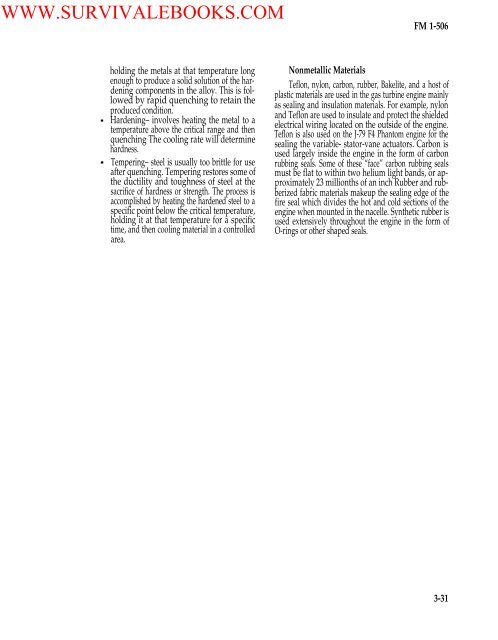FM 1-506 Fundamentals of Aircraft Power Plants ... - Survival Books
FM 1-506 Fundamentals of Aircraft Power Plants ... - Survival Books
FM 1-506 Fundamentals of Aircraft Power Plants ... - Survival Books
You also want an ePaper? Increase the reach of your titles
YUMPU automatically turns print PDFs into web optimized ePapers that Google loves.
WWW.SURVIVALEBOOKS.COM<strong>FM</strong> 1-<strong>506</strong>holding the metals at that temperature longenough to produce a solid solution <strong>of</strong> the hardeningcomponents in the alloy. This is followedby rapid quenching to retain theproduced condition.Hardening– involves heating the metal to atemperature above the critical range and thenquenching The cooling rate will determinehardness.Tempering– steel is usually too brittle for useafter quenching. Tempering restores some <strong>of</strong>the ductility and toughness <strong>of</strong> steel at thesacrifice <strong>of</strong> hardness or strength. The process isaccomplished by heating the hardened steel to aspecific point below the critical temperature,holding it at that temperature for a specifictime, and then cooling material in a controlledarea.Nonmetallic MaterialsTeflon, nylon, carbon, rubber, Bakelite, and a host <strong>of</strong>plastic materials are used in the gas turbine engine mainlyas sealing and insulation materials. For example, nylonand Teflon are used to insulate and protect the shieldedelectrical wiring located on the outside <strong>of</strong> the engine.Teflon is also used on the J-79 F4 Phantom engine for thesealing the variable- stator-vane actuators. Carbon isused largely inside the engine in the form <strong>of</strong> carbonrubbing seals. Some <strong>of</strong> these “face” carbon rubbing sealsmust be flat to within two helium light bands, or approximately23 millionths <strong>of</strong> an inch Rubber and rubberizedfabric materials makeup the sealing edge <strong>of</strong> thefire seal which divides the hot and cold sections <strong>of</strong> theengine when mounted in the nacelle. Synthetic rubber isused extensively throughout the engine in the form <strong>of</strong>O-rings or other shaped seals.3-31
















